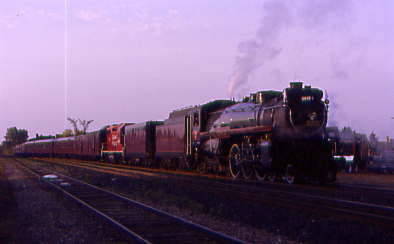
The wakeup call came at 6:00 AM and after a shower, I visited the casino, using two dollars of nickels and won over ten dollars in less than ten minutes. I then printed my Northwest Airlines boarding pass before I had a complimentary continental breakfast and checked out. I waited for the shuttle bus back to the train and was soon at the Soo Line station in Thief River Falls.


Minneapolis, St. Paul and Sault Ste. Marie (Soo Line) 2-8-2 1024 1941, nee Chicago, Indianapolis and Louisville Railway (Monon) 504 built by American Locomotive Company's Brooks Works in 1902. It was one of the first batch of twenty-five Mikados bought by the Monon that year. This is the last Monon Railroad steam locomotive in existence.

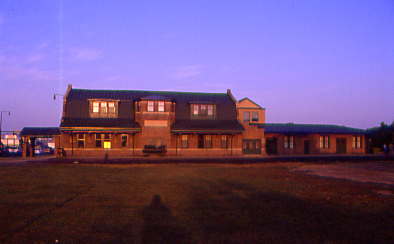

The Soo Line Thief River Falls station designed by the architects William Kenyon and Maurice Maine in the "American Craftsman" style. The Minneapolis, St. Paul and Sault Ste. Marie Railroad was not the first railroad to serve Thief River Falls. The St. Paul, Minneapolis and Manitoba Railway originally built a line to St. Hilaire, Minnesota, seven miles south of Thief River Falls, in 1883. Since it was inconvenient to haul freight to St. Hilaire for shipping, Thief River Falls officials decided to give the Great Northern Railway (the successor to the St. Paul, Minneapolis and Manitoba) a $750 incentive to extend the tracks north to Thief River Falls. This extension was completed in October 1892.
In 1888, the Minneapolis, St. Paul and Sault Ste. Marie Railroad was formed when Canadian Pacific helped to finance a merger between three smaller railroads. The new railroad, commonly known as the Soo Line, began construction of a line from Minneapolis to Winnipeg. This route went through territory traditionally served by the Great Northern, which upset James J. Hill, GN's owner. The Soo Line reached Thief River Falls in 1904 and made it a division point, with buildings including a roundhouse, mechanic shop, derrick house, several warehouses and a passenger depot. Other commercial development in the city followed the railroad's expansion and Soo Line traffic steadily increased. By 1913, the Soo Line's traffic dwarfed the traffic shipped by the Great Northern and the company decided to build a large, impressive depot as a sort of triumph over the GN.
It was in operation until 1967 when passenger train services ceased when the Soo Line discontinued the Winnipeger passenger train. At the height of its use, thirteen passenger trains arrived and departed from it every day. Local residents formed an organization to preserve the old depot and in 1994–1995, the City of Thief River Falls renovated and remodelled the building to serve as the city hall. The remodelling preserved important interior features such as the terrazzo floors and the wooden trim and doors in the passenger waiting area. It was listed on the National Register of Historic Places in 1995.
I then walked down to wait for Canadian Pacific 2816 to arrive.

Canadian Pacific 2816 reversing into the station for loading.

I walked around the end of the train for a picture.

Canadian Pacific 4-6-4 2816 awaiting its departure time.
Canadian Pacific 4-6-4 2816 "Empress" HistoryBuilt by the Montreal Locomotive Works in December 1930, it is the only non-streamlined Hudson to be preserved. The locomotive was primarily used in pulling passenger trains in revenue service for thirty years before it was retired in May 1960. In 1963, it was sold to F. Nelson Blount, who added it to his Steamtown, U.S.A. collection in Bellows Falls, Vermont. After becoming surplus in the collection by the National Park Service, 2816 was reacquired by the Canadian Pacific in 1998 and crews from BC Rail were hired to extensively restore it to operating condition.
Revenue serviceIt was first assigned to premier passenger service between Winnipeg and Fort William, Ontario. Following the introduction of semi-streamlined Royal Hudson locomotives in 1937, it was re-assigned to secondary passenger service between Windsor, Ontario and Quebec City and during the 1950's, it pulled commuter trains between Montreal and Rigaud, Quebec. In 1957, 2816 received a minor overhaul, with its tender being replaced with one from Royal Hudson 2822. The locomotive was retired from revenue service on May 26, 1960, after accumulating 2,046,000 miles and was subsequently used briefly as a stationary boiler at the St. Luc yards in Montreal.
Steamtown ownershipIn the early 1960's, F. Nelson Blount wanted to expand his Steamtown, U.S.A. collection and one of the locomotives he initially wanted to preserve was a 4-6-4 from the New York Central Railroad. Since all NYC 4-6-4s were scrapped by that time, Blount improvised by purchasing 2816 from the Canadian Pacific in December 1963. The locomotive was removed from the scrap lines of Angus, Ontario, and it was put on static display at Steamtown's first location in Bellows Falls, Vermont. During No. 2816's time on static display, the locomotive deteriorated from the outdoor elements and its condition worsened for several years. In the winter of 1983-1984, it was moved along with the rest of the collection to Scranton, Pennsylvania, where Steamtown was later reorganized as Steamtown National Historic Site under the ownership of the National Park Service. Following the reorganization, 2816 was deemed surplus in the collection and Steamtown wanted to dispose of it.
RestorationDuring the mid to late 1990's, the Canadian Pacific Railway's then-president and CEO, Robert Ritchie, reorganized the company and established the "Royal Canadian Pacific" excursion train to honour the railway's history and he sought for Canadian Pacific to operate their own steam excursion program. In 1998, the Canadian Pacific purchased 2816 from Steamtown and in exchange, the railway would move some equipment to Scranton. Canadian Pacific had heard of its availability via phone calls from BC Rail, who had been operating Canadian Pacific Royal Hudson 2860 as part of their own excursion program; the 2860 crews had been looking for replacement parts for the Royal Hudson and were offered to buy the entire locomotive by Steamtown.
A team of inspectors performed a preliminary inspection on 2816, and they pronounced that it was in good condition. In September 1998, the locomotive was coupled in a special consist led by Canadian Pacific GP38-2 3069, FP7 1400 and St. Lawrence and Hudson GP9u 8216, and it was ferried from Scranton to Montreal via Binghamton and Albany, New York, before travelling cross-country to the BC Rail steam workshop in North Vancouver, British Columbia. Canadian Pacific contracted the BC Rail steam shop crew, led by Al Broadfoot, to disassemble the steam engine and evaluate its condition; if it were salvageable, then they would restore it to operating condition, but if it were deteriorated beyond salvaging, then they would give it a cosmetic restoration for static display purposes.
When 2816 was disassembled, it was revealed that it was mechanically worn out, despite the preliminary inspectors having stated otherwise, but Rob Ritchie decided to approve a complete rebuild of the locomotive, regardless. Broadfoot and his team were able to obtain multiple plans and vital information about Canadian Pacific H1b class locomotives, including a collection of over 800 technical drawings provided by the Canada Science and Technology Museum and they used them as references for the project. Hundreds of replacement parts had to be fabricated by contractors in Vancouver, such as the cab, the running boards, the rod brasses, the superheater manifold, among others.
Contractors in the United States were hired to overhaul other major parts of 2816; the driving wheels were shipped to the Tennessee Valley Railroad Museum in Chattanooga, Tennessee and the boiler was shipped to Doyle McCormack and his crews in Portland, Oregon. 2816's firebox was converted from coal to oil firing and the tender received dual water intakes with Canadian and American threads. Canadian Pacific gained so much faith in the project that on April 19, 2000, the railway announced that it would be scheduled to return to service for their steam program by September of that year, but the deadline was pushed back, due to further challenges encountered in the restoration process. The project spanned more than two years and incurred costs between $3 million and $3.5 million.
Canadian Pacific excursion service and temporary hiatusOn August 15, 2001, 2816 passed its federal boiler inspection, and the following day, the locomotive was fired up for the first time in forty years, performing a series of test runs over three days on Canadian Pacific's Cascade Subdivision between Coquitlam and Mission. From September 19 to 23, with Al Broadfoot as the fireman and with Bill Stettler and Doyle McCormack taking turns as the engineer, 2816 pulled its first official inaugural excursion out of Port Moody, toured some of the Canadian Pacific mainlines for 672 miles over five days and then it stopped at Canadian Pacific's headquarters in Calgary, Alberta. The locomotive began pulling additional public relations excursions for the Canadian Pacific Railway, and it quickly received the name "The Empress".
On May 16, 2002, the locomotive pulled two excursions for the West Coast Express. Between May 24 and July 8, 2003, 2816 toured the Canadian Pacific between Alberta and Ontario, and the purpose of the tour was to spread further public awareness of Canadian Pacific and to raise money for the children's "Breakfast for Learning" program. On September 27, 2816 visited the Kamloops Heritage Railway and took part in a doubleheader excursion with Canadian National 2-8-0 2141. In May 2004, 2816 pulled the Royal Canadian Pacific consist while performing a 3,000-mile tour across the Canadian Pacific between Vancouver and Montreal, and it marked the first time in fifty years that a single steam locomotive pulled a cross-country passenger train in Canada, but it was assisted by three Canadian Pacific heritage diesels.
In early June 2004, the Empress was ferried behind a Soo Line SD60 over the CSX mainline between Buffalo, New York and Chicago, Illinois, hen it travelled to the Twin Cities area in Minnesota to participate in the Grand Excursion 2004 event, which celebrated the 150th anniversary of the Chicago and Rock Island Railroad's celebration train of 1854. 2816 pulled multiple public excursions for the event between the Twin Cities and the Quad Cities area in Iowa, using passenger coaches owned by Friends of the 261 and the last train took place on July 3; a doubleheader with Milwaukee Road 261 from St. Paul to La Crescent and return. 2816 returned from Minnesota to Calgary with a charity train later that same month.
The ExcursionI boarded the train and read USA Today until it was time to depart at 9:00 AM.

We ran beneath the grain elevators.
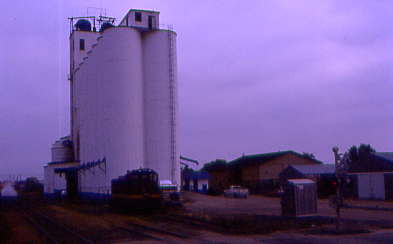
There was a locomotive at this grain elevator.
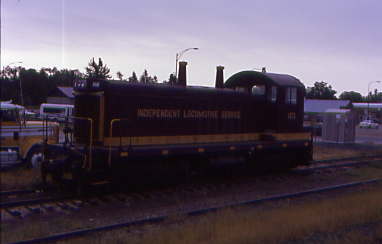
Independent Locomotive Service SW7 1373, nee Indiana Harbor Belt 8858 built by Electro-Moive Division in 1950.

As we entered Canadian Pacific's Thief River Falls Yard, we passed Canadian Pacific ES44AC 8766:2 and Soo Line GP40 2057.

Independent Locomotive Service GP10 1003 "Heron Lake", ex. Puget Sound and Pacific 1003, exx. MidSouth 1008, exxx. Illinois Central Gulf 8074, nee Illinois Central 9149 built by Electro-Motive Division in 1956 and Canadian Pacific SD40-2 5824 built by Electro-Motive Division in 1974.

Soo Line MP15AC 1546, nee Milwaukee Road 480 built by Electro-Motive Division in 1975.

Canadian Pacific Railway Engineering Services Maintenance-of-Way Transporter" van 420892, nee Canadian Pacific caboose 420982 built by the railway in the 1970's.

Canadian Pacific 8790 West at the north end of Thief River Falls yard.

We proceeded out of Thief River Falls into the Minnesota countryside.


We crossed the BNSF line at Dakota Junction.

Canadian Pacific 2816 rolled northwest through Newfolden, Strandquist and on towards Karlstad, passing through northern forest where farms are not located.


We took the 4,352 foot siding at Karlstad, Milepost 342.1 for Canadian Pacific 6043 East.
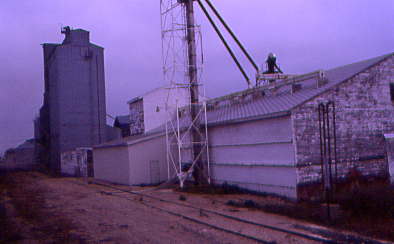

Passing the grain elevators here.
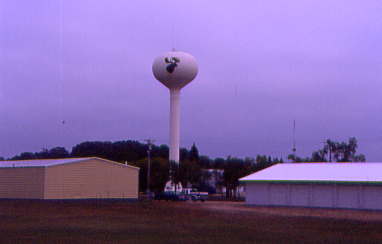
There is a moose on the water tower as Karlstad is the "Moose Capital of the North". Around 1883, a Swede named Carl August Carlson moved into the country west of Twin Lakes and established a homestead. In 1904, the Soo Line built through Carlson's farm and bought a townsite from him. The town was named Karlstad, honouring both Mr. Carlson and the City of Karlstad in Sweden.

Canadian Pacific 2816 returned to the mainline as we continued our trip towards Noyes.

We ran by the drooping sunflower plants on this overcast morning.
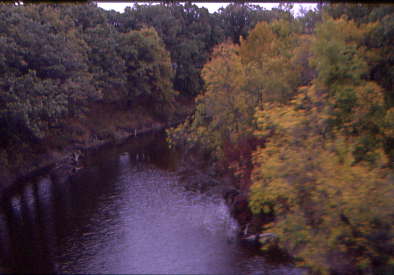
Crossed the South Branch of Two River.


The grain elevators at Lake Bronson, Milepost 355.1.

Horses out in this field.

We crossed the Middle Fork of Two River.
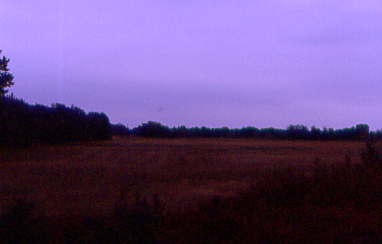
A field with a line of trees.

We came to a large field as we approached Noyes, where at 11:15 AM, we stopped behind a freight train waiting to clear customs to enter Canada and would be here until he went into Canada.

A Canadian Pacific freight train waiting to enter the country.

An eastbound Canadian Pacific train awaiting a crew. I enjoyed a pair of hot dogs as we waited.
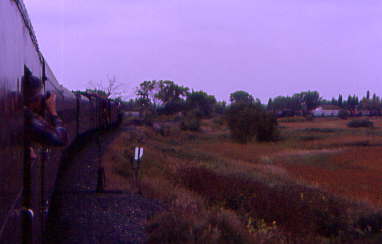
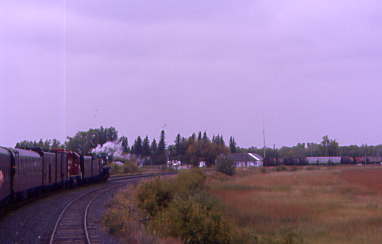

About an hour later, the waiting freight proceeded into Canada and we followed it up to the Custom House at the border. Our train crew went into the Custom Building to find out how Canadian Customs were going to work the train once crossed the border.

A BNSF freight waiting for a Canadian National train to arrive so they could swap trains.

A view looking north into Canada.

The train ran by the Custom House.


The Canadian National train arrived in Noyes from Emerson, Manitoba to swap trains with the BNSF. A few minutes later, we started moving forward.


Canadian Pacific 2816 was entering Canada.

The front part of our train crossing into our northern neighbour.

I had arrived in Canada.

We crossed a Canadian National line that runs just north of the border.

The "Cedar Rapids" had arrived in Canada and we stopped in Emerson Yard to clear Canadian Customs.